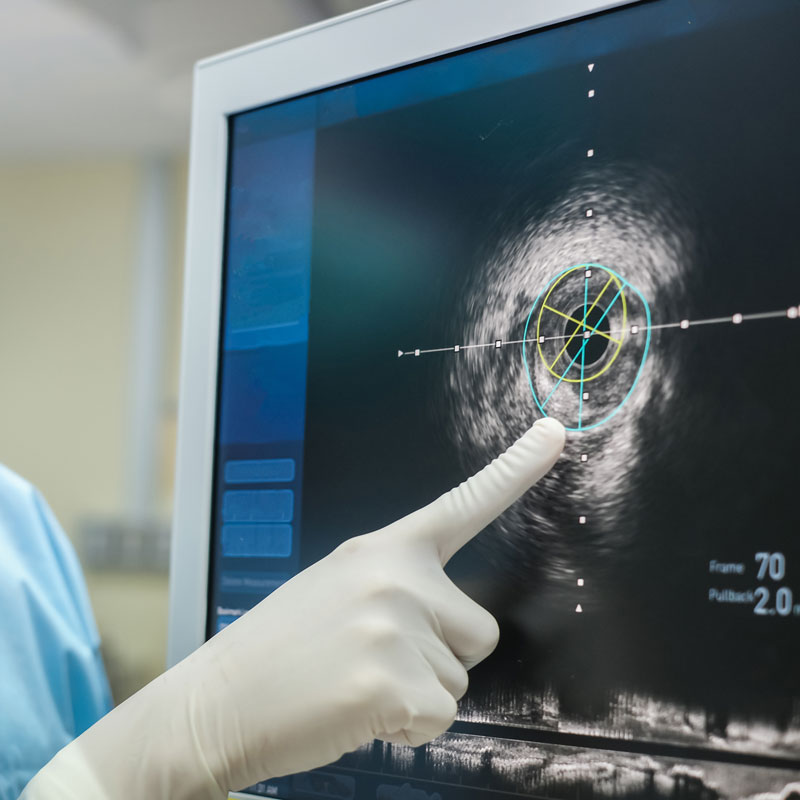Atherectomy
Atherectomy Procedures in the Phoenix Metro Area
The six locations of the Arizona Vein and Laser Institute in the Phoenix Metro area offer comprehensive vascular treatments, including atherectomy, to improve blood flow and health in patients of all ages. Our experience spans many years, and we have seen and successfully treated early and advanced stages of venous disease with modern techniques and state-of-the-art technology. We invite you to read our customer reviews to learn about the comforting experiences our patients have had with us and contact us to schedule a consultation today.

What Is an Atherectomy?
When discussing the atherectomy definition, we get a clear sense of the procedure just from its name. The term “ather” means fatty plaque, and an “ectomy” is the process of surgical removal. Vascular surgeons use atherectomy to remove fatty plaque from the walls of veins and arteries. When too many cholesterol particles are in the blood, they can build and form deposits on artery walls restricting blood flow. During an atherectomy, a small medical tool is used to remove these deposits.

Treatment for Coronary Artery and Peripheral Artery Disease
Endovascular specialists perform atherectomies to treat coronary artery disease and peripheral artery disease. Using a catheter with a sharp tip, our team can safely scrape the buildup of plaque off the walls of the arteries, store the removed particles in a small chamber, and completely remove it from the veins. Some patients may require multiple passes with the catheter, but the end result leaves artery walls clean, enabling blood to flow freely once again.
Atherectomy Vs. Angioplasty
Atherectomy and angioplasty procedures are both performed to improve blood flow in veins that are weakened or blocked with cholesterol plaque. While an angioplasty uses balloon inflation to widen an artery and sometimes a stent to help keep it open, atherectomy removes plaque from the body. Atherectomy is a preferred method for hard-to-reach areas that are not accessible with a stent, such as the branches and vessels that lead to extremities and cause peripheral artery disease.
What to Know Before and After an Atherectomy
The doctor will discuss how to prepare for an atherectomy properly. Guidelines may include avoiding certain medications that make blood clots difficult, such as aspirin, ibuprofen, and blood thinners. Patients will be advised which prescriptions they can continue to take up until the surgery. Once the surgery is complete, most patients can resume normal activities after a few days of downtime. The doctor will go over the exact timeline after the procedure.

How and Why an Atherectomy Is Performed
Similar to angioplasty, atherectomy starts with a small puncture in an artery. The surgeon gently guides the catheter through the veins until it reaches the narrowed portion. A typical procedure lasts for about two hours, and the doctor may need to make multiple passes with the catheter to remove the plaque altogether. The surgery is minimally invasive and only requires local anesthesia in the area where the catheter is inserted initially. Patients who have excessive cholesterol from genetics or a fatty diet experience hardening of the arteries and narrowing. Atherectomies are a safe and routine procedure to remove the buildup and improve blood flow to reduce cramping and swelling in the lower extremities.

Benefits of Atherectomy Procedures
If a doctor or vascular surgeon has recommended an atherectomy for you or a family member, there are benefits to this type of procedure, including:
- It is non-invasive
- There is little to no scarring
- We only use a local anesthesia
- There is minimal risk of complications
- There are no side effects
Atherectomy Frequently Asked Questions
Atherectomy is a medical procedure that helps restore blood flow through the arteries. It involves the removal of atherosclerosis from within the arteries, a condition commonly known as plaque buildup. Buildup in arteries can lead to reduced blood flow, which may cause chest pain, leg pain, or other symptoms.
Atherectomy and angioplasty are effective ways to clear blockages in arteries caused by a buildup of plaque. During an atherectomy, we use a laser or sharp blade to cut away or vaporize the plaque, clearing the artery. During angioplasty surgery, a balloon is inflated to push the plaque against the patient’s artery walls to open it. A stent is sometimes used to ensure the artery stays open after either of these procedures.
Candidates for atherectomy typically include individuals who have been diagnosed with peripheral artery disease (PAD) or coronary artery disease (CAD), where the plaque has hardened to a point where traditional angioplasty balloons or stents are not effective. Your healthcare provider may recommend an atherectomy if you experience symptoms, including leg pain when walking, numbness, weakness, or critical limb ischemia, which could lead to limb loss if not treated.
The primary benefit of undergoing an atherectomy procedure is the significant improvement in blood flow through the arteries. These benefits of an atherectomy can lead to the following:
- Reduction in symptoms of PAD or CAD, such as chest or leg pain
- Increased mobility and improved quality of life
- Decreased risk of limb loss in patients with severe PAD
- Potentially avoiding more invasive surgical procedures
Like any medical procedure, atherectomy comes with its set of risks, though they are relatively low. It’s important to discuss these risks with us to help you make an informed decision based on your specific health condition. Possible complications can include:
- Artery damage from the tools used during the procedure
- Blood clots or arterial dissection
- Bleeding at the catheter insertion site
- Rare chances of kidney damage due to the contrast dye used
The recovery process after an atherectomy is typically swift since it’s a minimally invasive procedure. Patients are generally able to walk within a few hours after the procedure and may return home the same day or the following day. Patients are usually advised to gradually increase their physical activity and follow lifestyle changes including regular exercise, stopping smoking, and eating a heart-healthy diet to ensure long-term success of the treatment. Recovery after an atherectomy includes:
- Monitoring for any immediate post-procedure complications
- Short-term medication to prevent blood clots
- Follow-up appointments to monitor artery healing and the effectiveness of the procedure
Atherectomies are performed by using a needle to create a slight incision in the skin, subsequently pushing in a narrow tube, or a sheath, into an artery located in the arm or groin. A catheter is then introduced via the sheath to the blood vessel and steered to the blocked artery by a guiding imaging technique known as fluoroscopy.
The next course of action is contingent on the atherectomy type being carried out. Your attending doctor will either utilize a laser to eliminate the blockage or a sharp blade to remove the plaque.
Depending on the blockage’s position and intensity, your doctor might be compelled to insert a stent to ensure the artery stays open. Once the revascularization is executed, the medical professional dispatches the catheter and the sheath and secures the opening in the blood vessel.
Learn If You Are a Candidate for Atherectomy
Contact the vascular specialists at the Arizona Vein and Laser Institute to learn more about our care and atherectomy procedures. We offer six convenient locations throughout the metro Phoenix, AZ area with highly qualified and experienced surgeons at each one.
